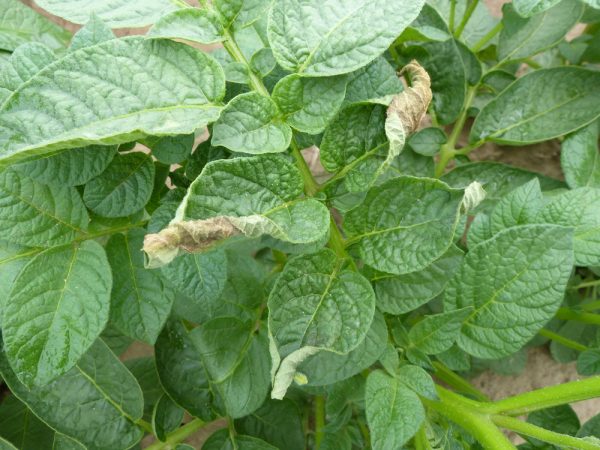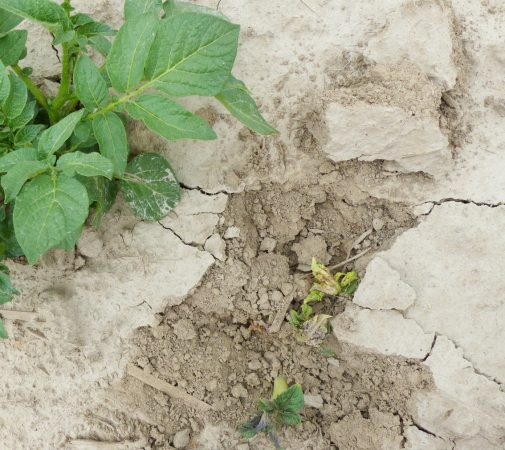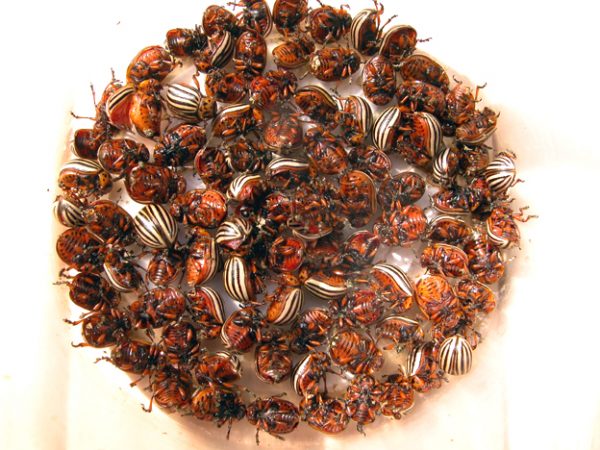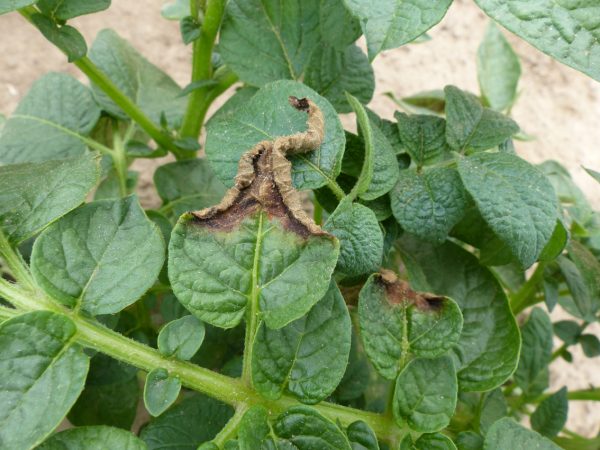
Crop Watch
News
Diseases
Pest Control
Ontario potato update: emergence concerns, CPB, good tuber sizes
June 26, 2020 By Stephanie Gordon
Potato fields across Ontario are at different growth stages ranging from flowering and bulking in southwestern Ontario to still emerging in Shelburne-Melancthon, according to Ontario potato specialist Eugenia Banks’ June 25 update.
Most of the fields in central Ontario that were planted in early May are filling the rows, and Banks says tuber size is good so far.
Banks shares she noticed leaf burning caused by heat and excessive evapotranspiration, but for growers not to worry because plants overgrow these leaf burning lesions.

Some potato crops showed evidence of leaf burning because of the excessive hot weather. Photos courtesy of Eugenia Banks.
Poor emergence in some areas
Poor potato emergence was noticeable in a few fields. Banks suggests that possible causes of poor emergence are crusted soil, differences seed vigour, cold temperatures and frost damage. In mid-May parts of Ontario saw temperatures drop below freezing on some nights, prompting frost concerns for many vegetable farmers.
According to Ontario’s Ministry of Food, Agriculture and Rural Affairs (OMAFRA) May 14 vegetable crop report, frost stress was reported in many regions that had started planting but many potato acres at the time had been recently planted so seed pieces remained safe from any frost layer.
In other jurisdictions, Banks says, glyphosate carry-over in seed is being investigated as the cause of poor emergence in fresh market potatoes.

Banks suggests that possible causes of poor emergence are crusted soil, differences seed vigour, cold temperatures and frost damage.
More Colorado potato beetles this season?
Hot days in May have accelerated the development of insects in Ontario potato fields and scouts have found Colorado potato beetles (CPB) mating and laying eggs. Banks bring up, if insecticide resistance is ruled out, what could be the reason for seeing more CPB this season?
“A possible explanation is that pre-cutting seed is more common than before,” Banks says. “When the seed is pre-cut and treated with an insecticide, it remains in storage for about two weeks until it’s planted.”
Banks then notes the growing timeline. Potato seed usually emerges three weeks after planting, and a week after emergence, CPBs may start infesting plants. “Thus, six weeks (42 days) after the seed treatment, the insecticide has lost some activity and CPBs are exposed to [a potentially] sublethal concentration of the insecticide,” Banks explains. “Something to think about.”
However, insecticide resistance is still a concern for growers. ManageResistanceNow is an online resource for farmers to learn about the best management practices when it comes to chemical resistance, including insecticide resistance. The ManageResistanceNow resource encourages farmers to follow insecticide best practices, such as when choosing chemical insecticides, select the right products for the right insect pest on the right crop. Follow practices such as rotating chemical groups and applying products according to label directions and economic thresholds. You can view the full list of insecticide resistance best management practices here.
Banks also notes that there have been many alerts of armyworms attacking cereal crops. While armyworms also infest potatoes, Banks says there have been no reports of potato fields being infested.

Dip tests are a simple technique where adult pests or larvae are immersed for a few seconds in insecticide solutions. The mortality rate determined for each insecticide indicates the products that are likely to be most effective under field conditions.
On the lookout for weather dependent diseases
Banks says there are certain diseases and physiological disorders (PD) that are likely to develop depending on the weather. However, Banks notes that Early blight is an edemic disease and it develops every year regardless of weather conditions.
Take a look at the table below to see what’s likely to develop based on weather conditions:
| Cool and wet weather | Warm and dry weather |
| Late blight | Alternaria brown spot |
| Blackleg | Early dying |
| Aerial stem rot | Black dot |
| Botrytis gray mold (PD) | Toxic Seed Piece Syndrome (PD) |
| White mold | Second growth (PD) |
| Phytophthora nicotianae | Fusarium wilt |
| Air pollution (PD) |
Stay updated with the latest potato crop updates by following @PotatoesCanada and #PotatoCropWatch on Twitter.
Print this page
